Leading and Managing Strategic Business Project: Leadership Theories
VerifiedAdded on 2023/04/23
|20
|4989
|245
Report
AI Summary
This report provides a comprehensive analysis of leading and managing strategic business projects, focusing on stakeholder collaboration, leadership theories, and motivation within project teams. It begins by emphasizing the importance of both internal (e.g., supervisors, mechanics) and external (e.g., clients, suppliers) stakeholders, outlining their key expectations and the challenges in ensuring effective collaboration. The report then delves into project management theories, recommending the management theory for its ability to improve understanding and management of work processes. It critically evaluates transactional and transformational leadership styles, highlighting essential leadership traits for project team leaders. Furthermore, the report addresses de-motivation factors affecting project teams and explores various motivational techniques, including the Equity Theory of Motivation, emphasizing the importance of self-motivation. The overall aim is to provide insights into effective project leadership and management strategies for successful project delivery.

Running head: LEADING & MANAGING STRATEGIC BUSINESS PROJECT
Leading & Managing Strategic Business Project
Name of Student
Name of University
Author Note
Leading & Managing Strategic Business Project
Name of Student
Name of University
Author Note
Paraphrase This Document
Need a fresh take? Get an instant paraphrase of this document with our AI Paraphraser
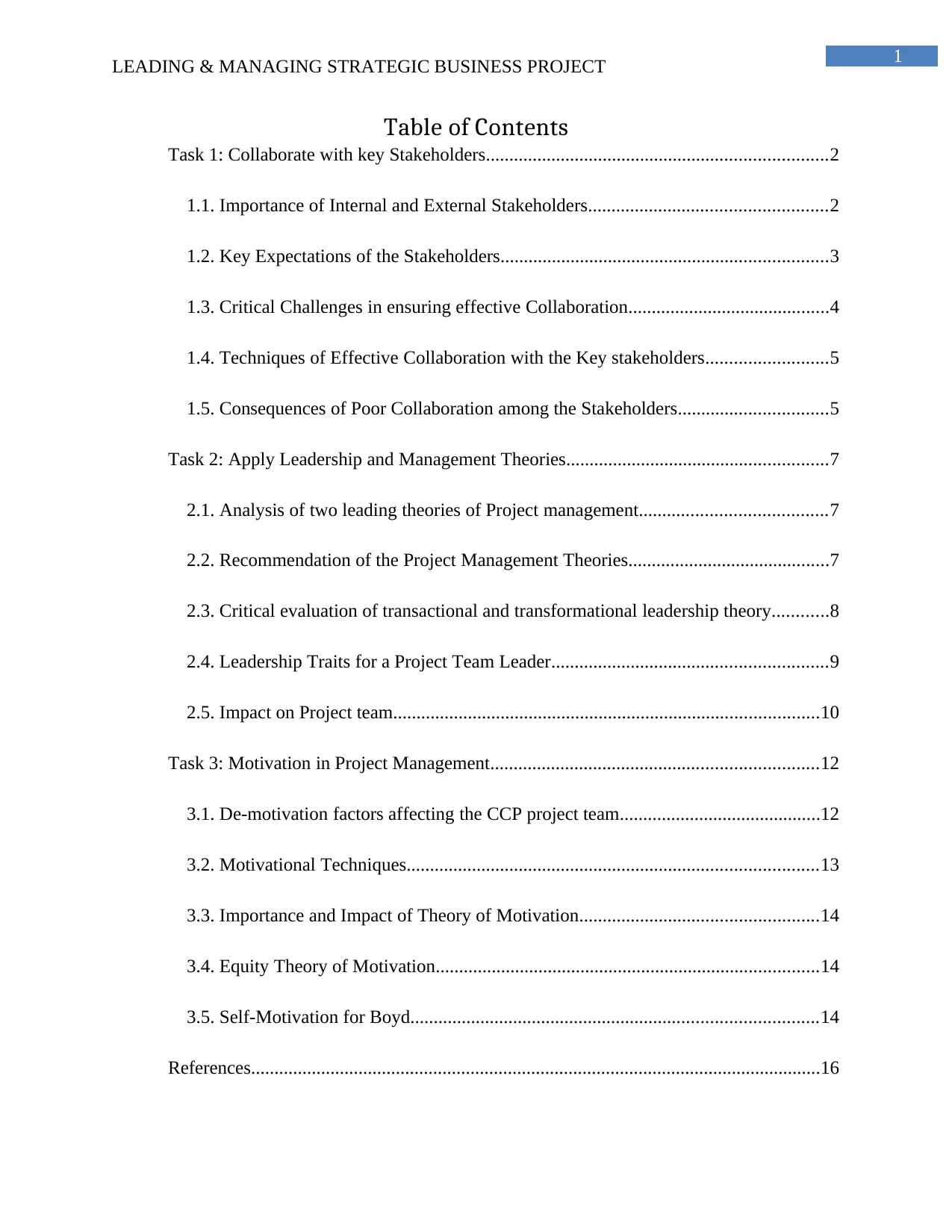
1
LEADING & MANAGING STRATEGIC BUSINESS PROJECT
Table of Contents
Task 1: Collaborate with key Stakeholders.........................................................................2
1.1. Importance of Internal and External Stakeholders...................................................2
1.2. Key Expectations of the Stakeholders......................................................................3
1.3. Critical Challenges in ensuring effective Collaboration...........................................4
1.4. Techniques of Effective Collaboration with the Key stakeholders..........................5
1.5. Consequences of Poor Collaboration among the Stakeholders................................5
Task 2: Apply Leadership and Management Theories........................................................7
2.1. Analysis of two leading theories of Project management........................................7
2.2. Recommendation of the Project Management Theories...........................................7
2.3. Critical evaluation of transactional and transformational leadership theory............8
2.4. Leadership Traits for a Project Team Leader...........................................................9
2.5. Impact on Project team...........................................................................................10
Task 3: Motivation in Project Management......................................................................12
3.1. De-motivation factors affecting the CCP project team...........................................12
3.2. Motivational Techniques........................................................................................13
3.3. Importance and Impact of Theory of Motivation...................................................14
3.4. Equity Theory of Motivation..................................................................................14
3.5. Self-Motivation for Boyd.......................................................................................14
References..........................................................................................................................16
LEADING & MANAGING STRATEGIC BUSINESS PROJECT
Table of Contents
Task 1: Collaborate with key Stakeholders.........................................................................2
1.1. Importance of Internal and External Stakeholders...................................................2
1.2. Key Expectations of the Stakeholders......................................................................3
1.3. Critical Challenges in ensuring effective Collaboration...........................................4
1.4. Techniques of Effective Collaboration with the Key stakeholders..........................5
1.5. Consequences of Poor Collaboration among the Stakeholders................................5
Task 2: Apply Leadership and Management Theories........................................................7
2.1. Analysis of two leading theories of Project management........................................7
2.2. Recommendation of the Project Management Theories...........................................7
2.3. Critical evaluation of transactional and transformational leadership theory............8
2.4. Leadership Traits for a Project Team Leader...........................................................9
2.5. Impact on Project team...........................................................................................10
Task 3: Motivation in Project Management......................................................................12
3.1. De-motivation factors affecting the CCP project team...........................................12
3.2. Motivational Techniques........................................................................................13
3.3. Importance and Impact of Theory of Motivation...................................................14
3.4. Equity Theory of Motivation..................................................................................14
3.5. Self-Motivation for Boyd.......................................................................................14
References..........................................................................................................................16
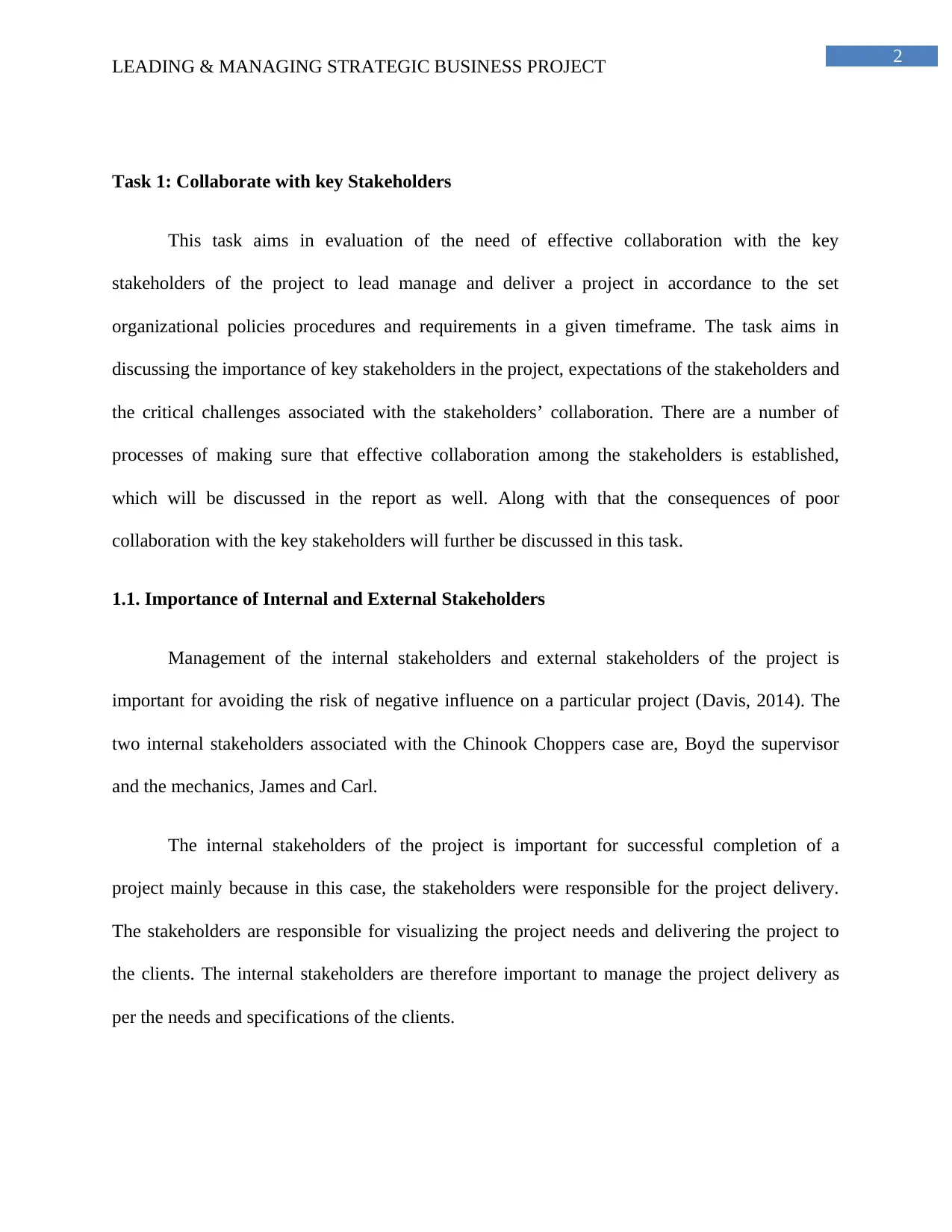
2
LEADING & MANAGING STRATEGIC BUSINESS PROJECT
Task 1: Collaborate with key Stakeholders
This task aims in evaluation of the need of effective collaboration with the key
stakeholders of the project to lead manage and deliver a project in accordance to the set
organizational policies procedures and requirements in a given timeframe. The task aims in
discussing the importance of key stakeholders in the project, expectations of the stakeholders and
the critical challenges associated with the stakeholders’ collaboration. There are a number of
processes of making sure that effective collaboration among the stakeholders is established,
which will be discussed in the report as well. Along with that the consequences of poor
collaboration with the key stakeholders will further be discussed in this task.
1.1. Importance of Internal and External Stakeholders
Management of the internal stakeholders and external stakeholders of the project is
important for avoiding the risk of negative influence on a particular project (Davis, 2014). The
two internal stakeholders associated with the Chinook Choppers case are, Boyd the supervisor
and the mechanics, James and Carl.
The internal stakeholders of the project is important for successful completion of a
project mainly because in this case, the stakeholders were responsible for the project delivery.
The stakeholders are responsible for visualizing the project needs and delivering the project to
the clients. The internal stakeholders are therefore important to manage the project delivery as
per the needs and specifications of the clients.
LEADING & MANAGING STRATEGIC BUSINESS PROJECT
Task 1: Collaborate with key Stakeholders
This task aims in evaluation of the need of effective collaboration with the key
stakeholders of the project to lead manage and deliver a project in accordance to the set
organizational policies procedures and requirements in a given timeframe. The task aims in
discussing the importance of key stakeholders in the project, expectations of the stakeholders and
the critical challenges associated with the stakeholders’ collaboration. There are a number of
processes of making sure that effective collaboration among the stakeholders is established,
which will be discussed in the report as well. Along with that the consequences of poor
collaboration with the key stakeholders will further be discussed in this task.
1.1. Importance of Internal and External Stakeholders
Management of the internal stakeholders and external stakeholders of the project is
important for avoiding the risk of negative influence on a particular project (Davis, 2014). The
two internal stakeholders associated with the Chinook Choppers case are, Boyd the supervisor
and the mechanics, James and Carl.
The internal stakeholders of the project is important for successful completion of a
project mainly because in this case, the stakeholders were responsible for the project delivery.
The stakeholders are responsible for visualizing the project needs and delivering the project to
the clients. The internal stakeholders are therefore important to manage the project delivery as
per the needs and specifications of the clients.
⊘ This is a preview!⊘
Do you want full access?
Subscribe today to unlock all pages.

Trusted by 1+ million students worldwide
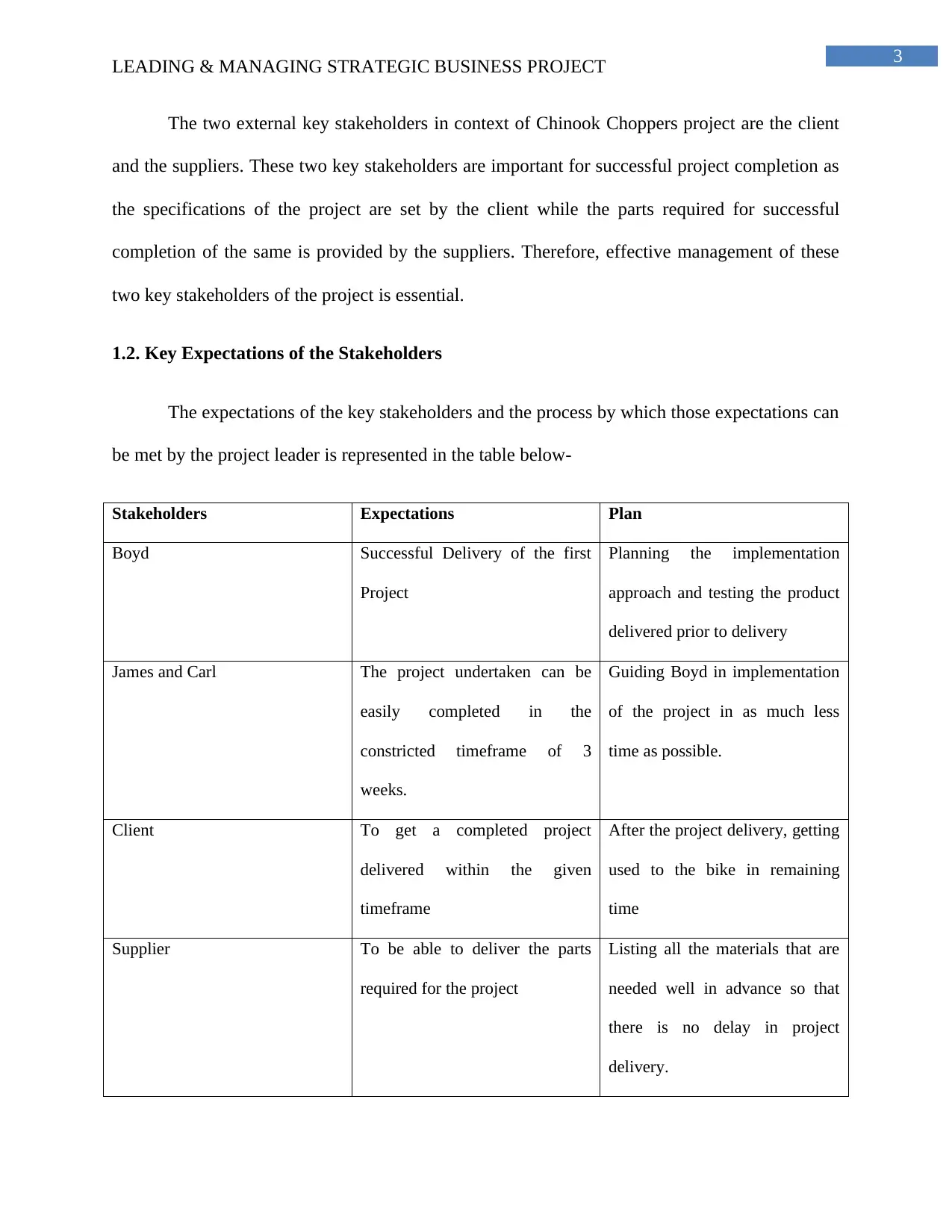
3
LEADING & MANAGING STRATEGIC BUSINESS PROJECT
The two external key stakeholders in context of Chinook Choppers project are the client
and the suppliers. These two key stakeholders are important for successful project completion as
the specifications of the project are set by the client while the parts required for successful
completion of the same is provided by the suppliers. Therefore, effective management of these
two key stakeholders of the project is essential.
1.2. Key Expectations of the Stakeholders
The expectations of the key stakeholders and the process by which those expectations can
be met by the project leader is represented in the table below-
Stakeholders Expectations Plan
Boyd Successful Delivery of the first
Project
Planning the implementation
approach and testing the product
delivered prior to delivery
James and Carl The project undertaken can be
easily completed in the
constricted timeframe of 3
weeks.
Guiding Boyd in implementation
of the project in as much less
time as possible.
Client To get a completed project
delivered within the given
timeframe
After the project delivery, getting
used to the bike in remaining
time
Supplier To be able to deliver the parts
required for the project
Listing all the materials that are
needed well in advance so that
there is no delay in project
delivery.
LEADING & MANAGING STRATEGIC BUSINESS PROJECT
The two external key stakeholders in context of Chinook Choppers project are the client
and the suppliers. These two key stakeholders are important for successful project completion as
the specifications of the project are set by the client while the parts required for successful
completion of the same is provided by the suppliers. Therefore, effective management of these
two key stakeholders of the project is essential.
1.2. Key Expectations of the Stakeholders
The expectations of the key stakeholders and the process by which those expectations can
be met by the project leader is represented in the table below-
Stakeholders Expectations Plan
Boyd Successful Delivery of the first
Project
Planning the implementation
approach and testing the product
delivered prior to delivery
James and Carl The project undertaken can be
easily completed in the
constricted timeframe of 3
weeks.
Guiding Boyd in implementation
of the project in as much less
time as possible.
Client To get a completed project
delivered within the given
timeframe
After the project delivery, getting
used to the bike in remaining
time
Supplier To be able to deliver the parts
required for the project
Listing all the materials that are
needed well in advance so that
there is no delay in project
delivery.
Paraphrase This Document
Need a fresh take? Get an instant paraphrase of this document with our AI Paraphraser
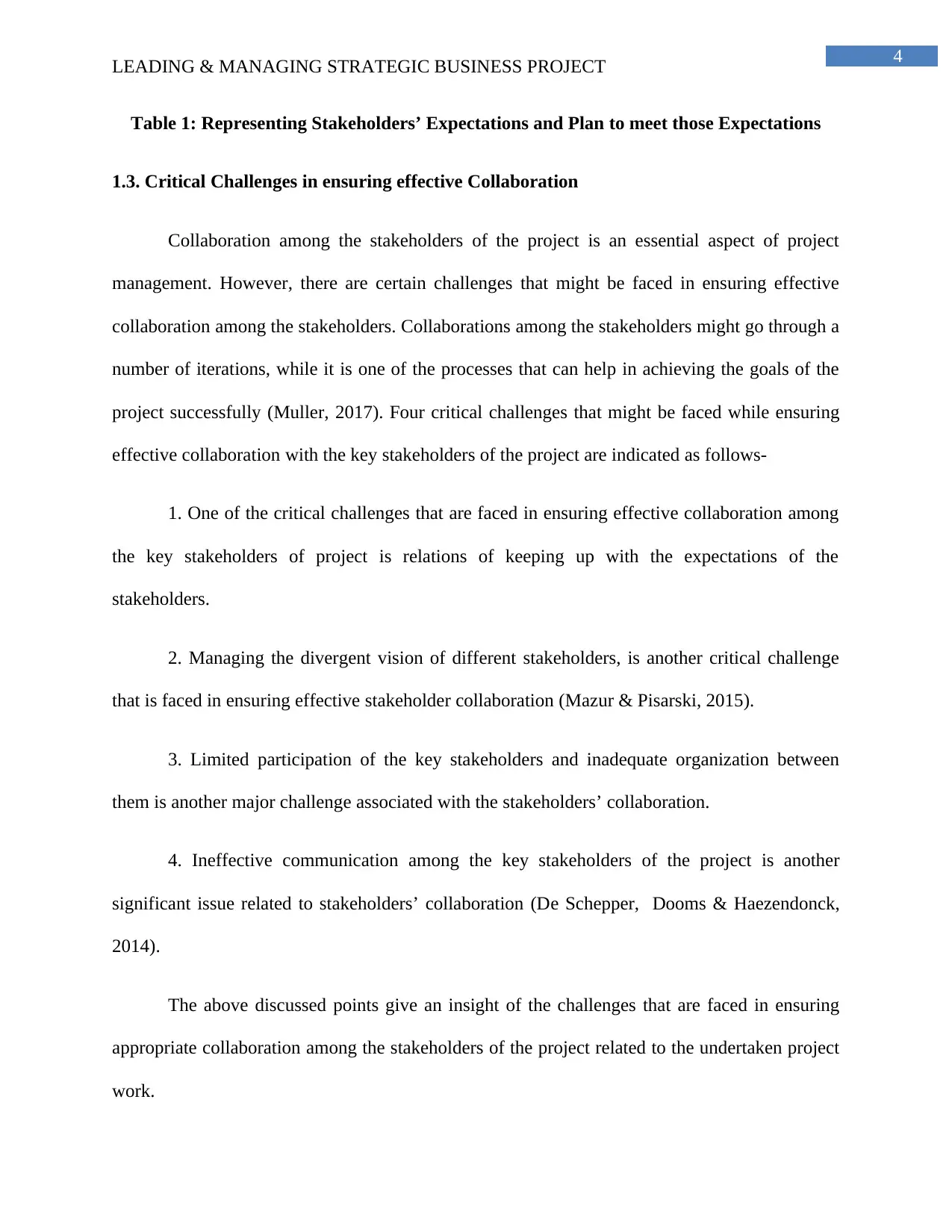
4
LEADING & MANAGING STRATEGIC BUSINESS PROJECT
Table 1: Representing Stakeholders’ Expectations and Plan to meet those Expectations
1.3. Critical Challenges in ensuring effective Collaboration
Collaboration among the stakeholders of the project is an essential aspect of project
management. However, there are certain challenges that might be faced in ensuring effective
collaboration among the stakeholders. Collaborations among the stakeholders might go through a
number of iterations, while it is one of the processes that can help in achieving the goals of the
project successfully (Muller, 2017). Four critical challenges that might be faced while ensuring
effective collaboration with the key stakeholders of the project are indicated as follows-
1. One of the critical challenges that are faced in ensuring effective collaboration among
the key stakeholders of project is relations of keeping up with the expectations of the
stakeholders.
2. Managing the divergent vision of different stakeholders, is another critical challenge
that is faced in ensuring effective stakeholder collaboration (Mazur & Pisarski, 2015).
3. Limited participation of the key stakeholders and inadequate organization between
them is another major challenge associated with the stakeholders’ collaboration.
4. Ineffective communication among the key stakeholders of the project is another
significant issue related to stakeholders’ collaboration (De Schepper, Dooms & Haezendonck,
2014).
The above discussed points give an insight of the challenges that are faced in ensuring
appropriate collaboration among the stakeholders of the project related to the undertaken project
work.
LEADING & MANAGING STRATEGIC BUSINESS PROJECT
Table 1: Representing Stakeholders’ Expectations and Plan to meet those Expectations
1.3. Critical Challenges in ensuring effective Collaboration
Collaboration among the stakeholders of the project is an essential aspect of project
management. However, there are certain challenges that might be faced in ensuring effective
collaboration among the stakeholders. Collaborations among the stakeholders might go through a
number of iterations, while it is one of the processes that can help in achieving the goals of the
project successfully (Muller, 2017). Four critical challenges that might be faced while ensuring
effective collaboration with the key stakeholders of the project are indicated as follows-
1. One of the critical challenges that are faced in ensuring effective collaboration among
the key stakeholders of project is relations of keeping up with the expectations of the
stakeholders.
2. Managing the divergent vision of different stakeholders, is another critical challenge
that is faced in ensuring effective stakeholder collaboration (Mazur & Pisarski, 2015).
3. Limited participation of the key stakeholders and inadequate organization between
them is another major challenge associated with the stakeholders’ collaboration.
4. Ineffective communication among the key stakeholders of the project is another
significant issue related to stakeholders’ collaboration (De Schepper, Dooms & Haezendonck,
2014).
The above discussed points give an insight of the challenges that are faced in ensuring
appropriate collaboration among the stakeholders of the project related to the undertaken project
work.
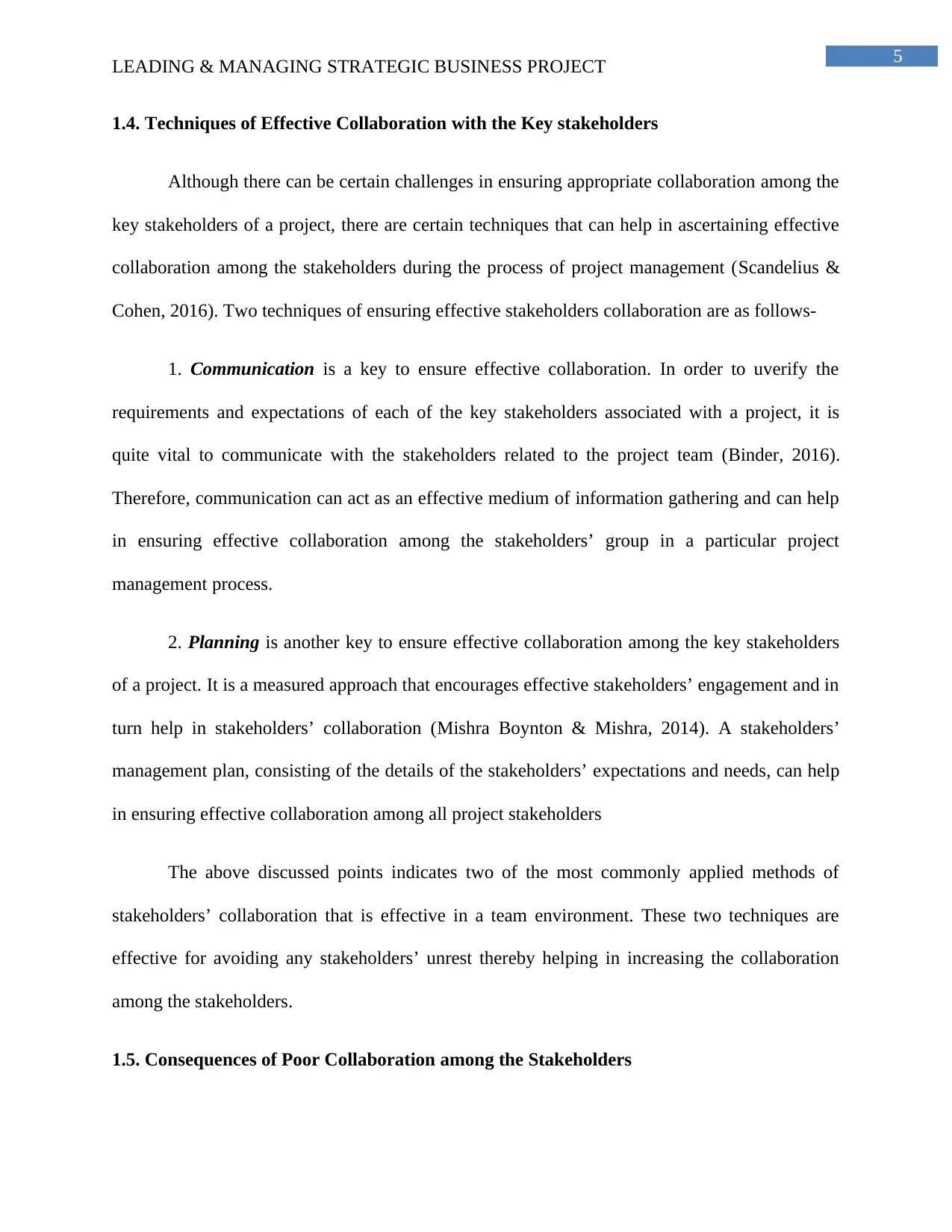
5
LEADING & MANAGING STRATEGIC BUSINESS PROJECT
1.4. Techniques of Effective Collaboration with the Key stakeholders
Although there can be certain challenges in ensuring appropriate collaboration among the
key stakeholders of a project, there are certain techniques that can help in ascertaining effective
collaboration among the stakeholders during the process of project management (Scandelius &
Cohen, 2016). Two techniques of ensuring effective stakeholders collaboration are as follows-
1. Communication is a key to ensure effective collaboration. In order to uverify the
requirements and expectations of each of the key stakeholders associated with a project, it is
quite vital to communicate with the stakeholders related to the project team (Binder, 2016).
Therefore, communication can act as an effective medium of information gathering and can help
in ensuring effective collaboration among the stakeholders’ group in a particular project
management process.
2. Planning is another key to ensure effective collaboration among the key stakeholders
of a project. It is a measured approach that encourages effective stakeholders’ engagement and in
turn help in stakeholders’ collaboration (Mishra Boynton & Mishra, 2014). A stakeholders’
management plan, consisting of the details of the stakeholders’ expectations and needs, can help
in ensuring effective collaboration among all project stakeholders
The above discussed points indicates two of the most commonly applied methods of
stakeholders’ collaboration that is effective in a team environment. These two techniques are
effective for avoiding any stakeholders’ unrest thereby helping in increasing the collaboration
among the stakeholders.
1.5. Consequences of Poor Collaboration among the Stakeholders
LEADING & MANAGING STRATEGIC BUSINESS PROJECT
1.4. Techniques of Effective Collaboration with the Key stakeholders
Although there can be certain challenges in ensuring appropriate collaboration among the
key stakeholders of a project, there are certain techniques that can help in ascertaining effective
collaboration among the stakeholders during the process of project management (Scandelius &
Cohen, 2016). Two techniques of ensuring effective stakeholders collaboration are as follows-
1. Communication is a key to ensure effective collaboration. In order to uverify the
requirements and expectations of each of the key stakeholders associated with a project, it is
quite vital to communicate with the stakeholders related to the project team (Binder, 2016).
Therefore, communication can act as an effective medium of information gathering and can help
in ensuring effective collaboration among the stakeholders’ group in a particular project
management process.
2. Planning is another key to ensure effective collaboration among the key stakeholders
of a project. It is a measured approach that encourages effective stakeholders’ engagement and in
turn help in stakeholders’ collaboration (Mishra Boynton & Mishra, 2014). A stakeholders’
management plan, consisting of the details of the stakeholders’ expectations and needs, can help
in ensuring effective collaboration among all project stakeholders
The above discussed points indicates two of the most commonly applied methods of
stakeholders’ collaboration that is effective in a team environment. These two techniques are
effective for avoiding any stakeholders’ unrest thereby helping in increasing the collaboration
among the stakeholders.
1.5. Consequences of Poor Collaboration among the Stakeholders
⊘ This is a preview!⊘
Do you want full access?
Subscribe today to unlock all pages.

Trusted by 1+ million students worldwide
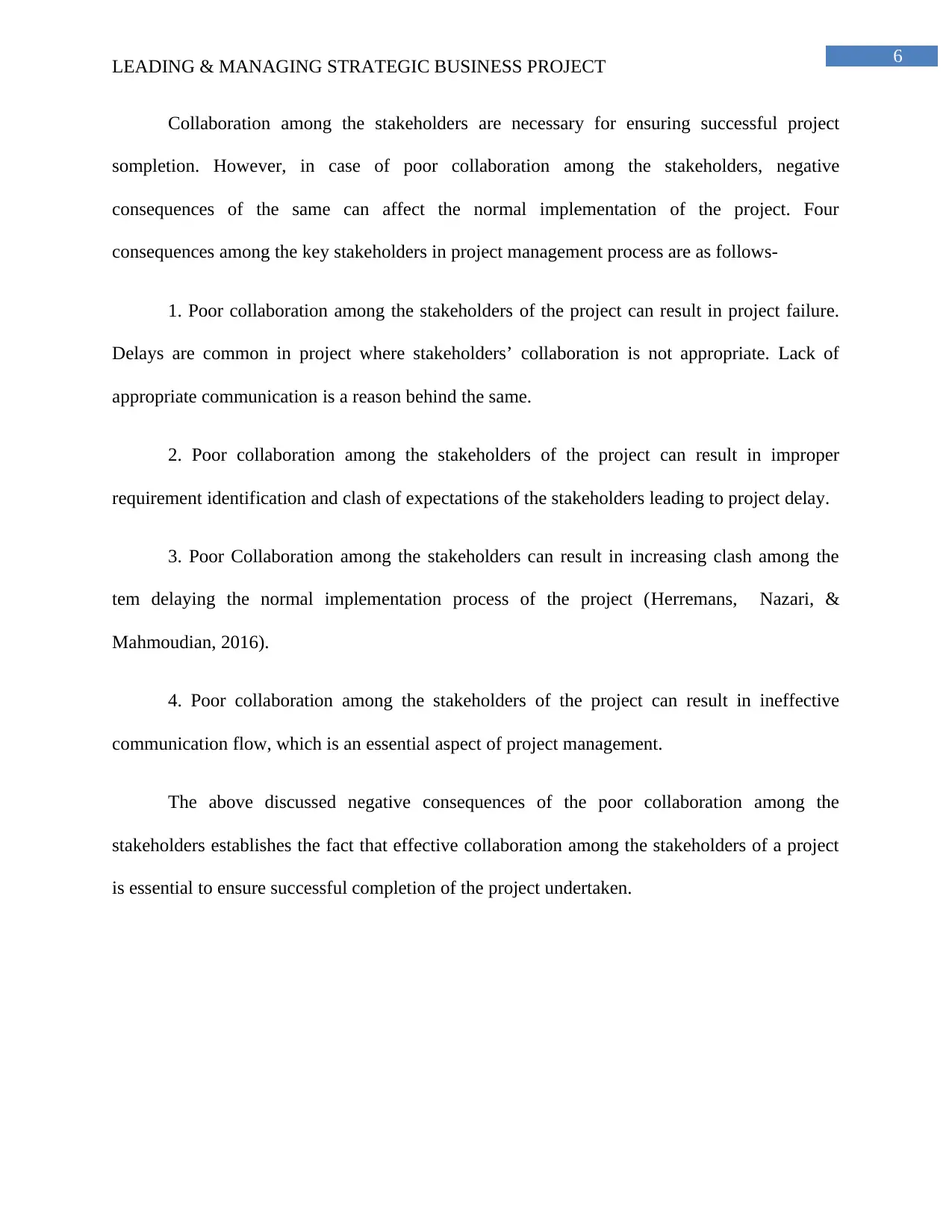
6
LEADING & MANAGING STRATEGIC BUSINESS PROJECT
Collaboration among the stakeholders are necessary for ensuring successful project
sompletion. However, in case of poor collaboration among the stakeholders, negative
consequences of the same can affect the normal implementation of the project. Four
consequences among the key stakeholders in project management process are as follows-
1. Poor collaboration among the stakeholders of the project can result in project failure.
Delays are common in project where stakeholders’ collaboration is not appropriate. Lack of
appropriate communication is a reason behind the same.
2. Poor collaboration among the stakeholders of the project can result in improper
requirement identification and clash of expectations of the stakeholders leading to project delay.
3. Poor Collaboration among the stakeholders can result in increasing clash among the
tem delaying the normal implementation process of the project (Herremans, Nazari, &
Mahmoudian, 2016).
4. Poor collaboration among the stakeholders of the project can result in ineffective
communication flow, which is an essential aspect of project management.
The above discussed negative consequences of the poor collaboration among the
stakeholders establishes the fact that effective collaboration among the stakeholders of a project
is essential to ensure successful completion of the project undertaken.
LEADING & MANAGING STRATEGIC BUSINESS PROJECT
Collaboration among the stakeholders are necessary for ensuring successful project
sompletion. However, in case of poor collaboration among the stakeholders, negative
consequences of the same can affect the normal implementation of the project. Four
consequences among the key stakeholders in project management process are as follows-
1. Poor collaboration among the stakeholders of the project can result in project failure.
Delays are common in project where stakeholders’ collaboration is not appropriate. Lack of
appropriate communication is a reason behind the same.
2. Poor collaboration among the stakeholders of the project can result in improper
requirement identification and clash of expectations of the stakeholders leading to project delay.
3. Poor Collaboration among the stakeholders can result in increasing clash among the
tem delaying the normal implementation process of the project (Herremans, Nazari, &
Mahmoudian, 2016).
4. Poor collaboration among the stakeholders of the project can result in ineffective
communication flow, which is an essential aspect of project management.
The above discussed negative consequences of the poor collaboration among the
stakeholders establishes the fact that effective collaboration among the stakeholders of a project
is essential to ensure successful completion of the project undertaken.
Paraphrase This Document
Need a fresh take? Get an instant paraphrase of this document with our AI Paraphraser
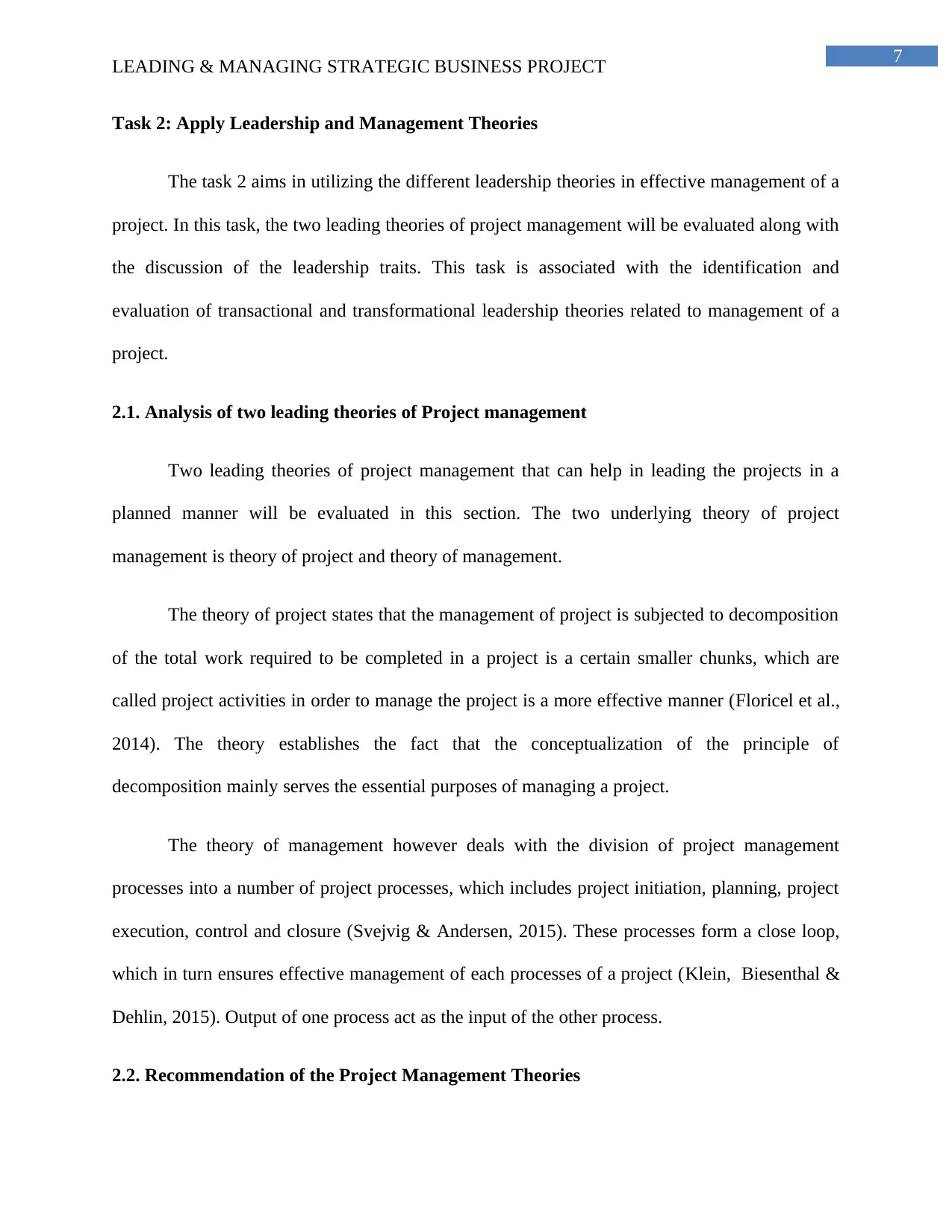
7
LEADING & MANAGING STRATEGIC BUSINESS PROJECT
Task 2: Apply Leadership and Management Theories
The task 2 aims in utilizing the different leadership theories in effective management of a
project. In this task, the two leading theories of project management will be evaluated along with
the discussion of the leadership traits. This task is associated with the identification and
evaluation of transactional and transformational leadership theories related to management of a
project.
2.1. Analysis of two leading theories of Project management
Two leading theories of project management that can help in leading the projects in a
planned manner will be evaluated in this section. The two underlying theory of project
management is theory of project and theory of management.
The theory of project states that the management of project is subjected to decomposition
of the total work required to be completed in a project is a certain smaller chunks, which are
called project activities in order to manage the project is a more effective manner (Floricel et al.,
2014). The theory establishes the fact that the conceptualization of the principle of
decomposition mainly serves the essential purposes of managing a project.
The theory of management however deals with the division of project management
processes into a number of project processes, which includes project initiation, planning, project
execution, control and closure (Svejvig & Andersen, 2015). These processes form a close loop,
which in turn ensures effective management of each processes of a project (Klein, Biesenthal &
Dehlin, 2015). Output of one process act as the input of the other process.
2.2. Recommendation of the Project Management Theories
LEADING & MANAGING STRATEGIC BUSINESS PROJECT
Task 2: Apply Leadership and Management Theories
The task 2 aims in utilizing the different leadership theories in effective management of a
project. In this task, the two leading theories of project management will be evaluated along with
the discussion of the leadership traits. This task is associated with the identification and
evaluation of transactional and transformational leadership theories related to management of a
project.
2.1. Analysis of two leading theories of Project management
Two leading theories of project management that can help in leading the projects in a
planned manner will be evaluated in this section. The two underlying theory of project
management is theory of project and theory of management.
The theory of project states that the management of project is subjected to decomposition
of the total work required to be completed in a project is a certain smaller chunks, which are
called project activities in order to manage the project is a more effective manner (Floricel et al.,
2014). The theory establishes the fact that the conceptualization of the principle of
decomposition mainly serves the essential purposes of managing a project.
The theory of management however deals with the division of project management
processes into a number of project processes, which includes project initiation, planning, project
execution, control and closure (Svejvig & Andersen, 2015). These processes form a close loop,
which in turn ensures effective management of each processes of a project (Klein, Biesenthal &
Dehlin, 2015). Output of one process act as the input of the other process.
2.2. Recommendation of the Project Management Theories
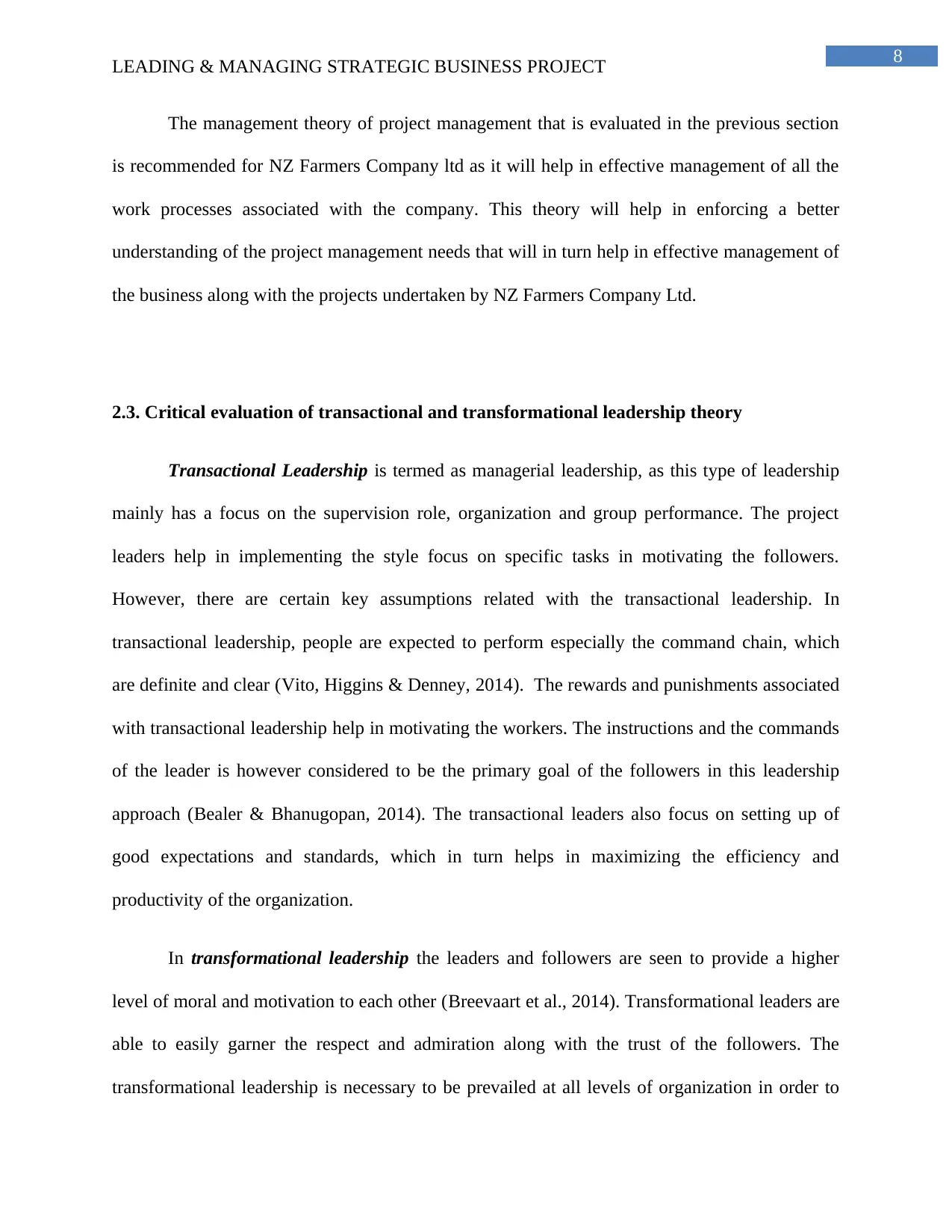
8
LEADING & MANAGING STRATEGIC BUSINESS PROJECT
The management theory of project management that is evaluated in the previous section
is recommended for NZ Farmers Company ltd as it will help in effective management of all the
work processes associated with the company. This theory will help in enforcing a better
understanding of the project management needs that will in turn help in effective management of
the business along with the projects undertaken by NZ Farmers Company Ltd.
2.3. Critical evaluation of transactional and transformational leadership theory
Transactional Leadership is termed as managerial leadership, as this type of leadership
mainly has a focus on the supervision role, organization and group performance. The project
leaders help in implementing the style focus on specific tasks in motivating the followers.
However, there are certain key assumptions related with the transactional leadership. In
transactional leadership, people are expected to perform especially the command chain, which
are definite and clear (Vito, Higgins & Denney, 2014). The rewards and punishments associated
with transactional leadership help in motivating the workers. The instructions and the commands
of the leader is however considered to be the primary goal of the followers in this leadership
approach (Bealer & Bhanugopan, 2014). The transactional leaders also focus on setting up of
good expectations and standards, which in turn helps in maximizing the efficiency and
productivity of the organization.
In transformational leadership the leaders and followers are seen to provide a higher
level of moral and motivation to each other (Breevaart et al., 2014). Transformational leaders are
able to easily garner the respect and admiration along with the trust of the followers. The
transformational leadership is necessary to be prevailed at all levels of organization in order to
LEADING & MANAGING STRATEGIC BUSINESS PROJECT
The management theory of project management that is evaluated in the previous section
is recommended for NZ Farmers Company ltd as it will help in effective management of all the
work processes associated with the company. This theory will help in enforcing a better
understanding of the project management needs that will in turn help in effective management of
the business along with the projects undertaken by NZ Farmers Company Ltd.
2.3. Critical evaluation of transactional and transformational leadership theory
Transactional Leadership is termed as managerial leadership, as this type of leadership
mainly has a focus on the supervision role, organization and group performance. The project
leaders help in implementing the style focus on specific tasks in motivating the followers.
However, there are certain key assumptions related with the transactional leadership. In
transactional leadership, people are expected to perform especially the command chain, which
are definite and clear (Vito, Higgins & Denney, 2014). The rewards and punishments associated
with transactional leadership help in motivating the workers. The instructions and the commands
of the leader is however considered to be the primary goal of the followers in this leadership
approach (Bealer & Bhanugopan, 2014). The transactional leaders also focus on setting up of
good expectations and standards, which in turn helps in maximizing the efficiency and
productivity of the organization.
In transformational leadership the leaders and followers are seen to provide a higher
level of moral and motivation to each other (Breevaart et al., 2014). Transformational leaders are
able to easily garner the respect and admiration along with the trust of the followers. The
transformational leadership is necessary to be prevailed at all levels of organization in order to
⊘ This is a preview!⊘
Do you want full access?
Subscribe today to unlock all pages.

Trusted by 1+ million students worldwide
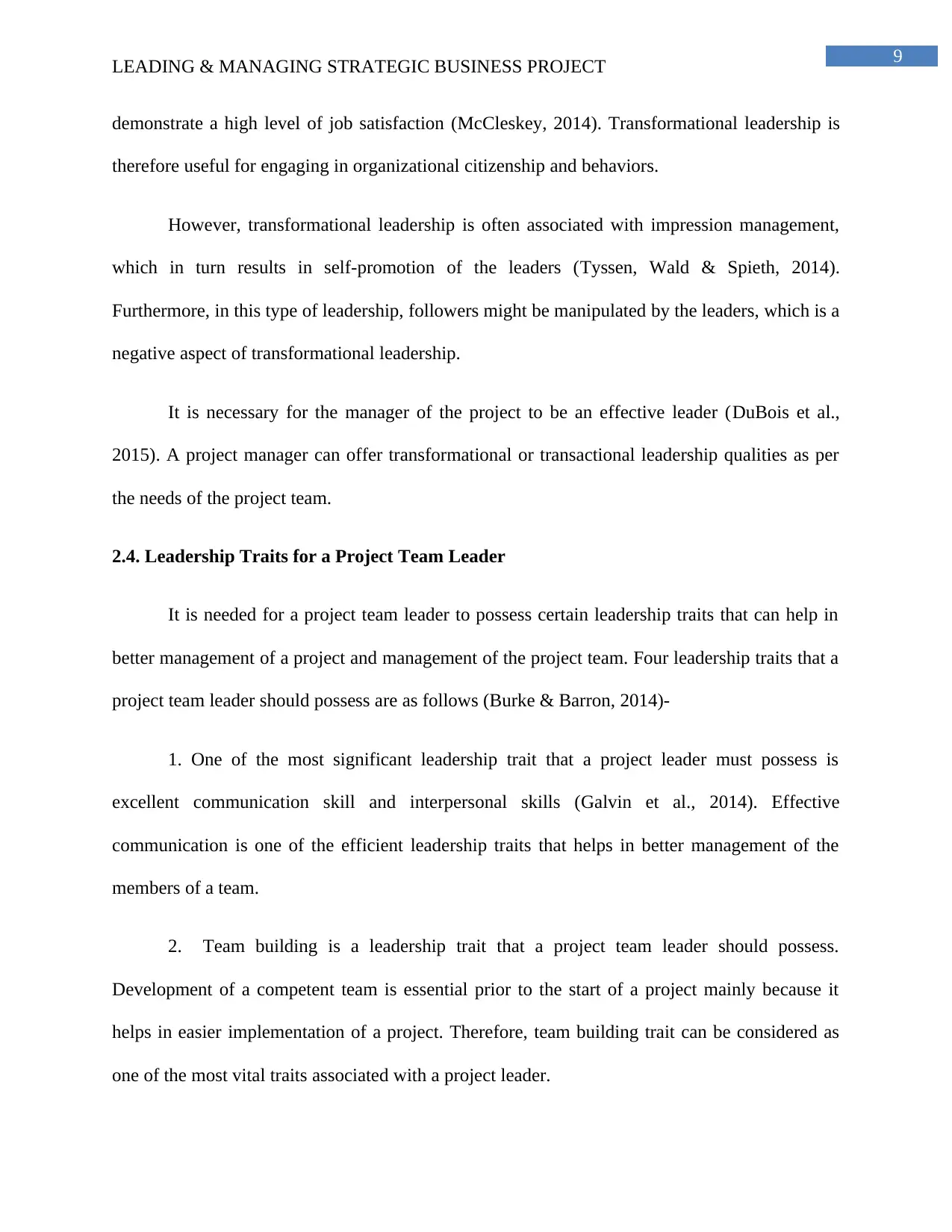
9
LEADING & MANAGING STRATEGIC BUSINESS PROJECT
demonstrate a high level of job satisfaction (McCleskey, 2014). Transformational leadership is
therefore useful for engaging in organizational citizenship and behaviors.
However, transformational leadership is often associated with impression management,
which in turn results in self-promotion of the leaders (Tyssen, Wald & Spieth, 2014).
Furthermore, in this type of leadership, followers might be manipulated by the leaders, which is a
negative aspect of transformational leadership.
It is necessary for the manager of the project to be an effective leader (DuBois et al.,
2015). A project manager can offer transformational or transactional leadership qualities as per
the needs of the project team.
2.4. Leadership Traits for a Project Team Leader
It is needed for a project team leader to possess certain leadership traits that can help in
better management of a project and management of the project team. Four leadership traits that a
project team leader should possess are as follows (Burke & Barron, 2014)-
1. One of the most significant leadership trait that a project leader must possess is
excellent communication skill and interpersonal skills (Galvin et al., 2014). Effective
communication is one of the efficient leadership traits that helps in better management of the
members of a team.
2. Team building is a leadership trait that a project team leader should possess.
Development of a competent team is essential prior to the start of a project mainly because it
helps in easier implementation of a project. Therefore, team building trait can be considered as
one of the most vital traits associated with a project leader.
LEADING & MANAGING STRATEGIC BUSINESS PROJECT
demonstrate a high level of job satisfaction (McCleskey, 2014). Transformational leadership is
therefore useful for engaging in organizational citizenship and behaviors.
However, transformational leadership is often associated with impression management,
which in turn results in self-promotion of the leaders (Tyssen, Wald & Spieth, 2014).
Furthermore, in this type of leadership, followers might be manipulated by the leaders, which is a
negative aspect of transformational leadership.
It is necessary for the manager of the project to be an effective leader (DuBois et al.,
2015). A project manager can offer transformational or transactional leadership qualities as per
the needs of the project team.
2.4. Leadership Traits for a Project Team Leader
It is needed for a project team leader to possess certain leadership traits that can help in
better management of a project and management of the project team. Four leadership traits that a
project team leader should possess are as follows (Burke & Barron, 2014)-
1. One of the most significant leadership trait that a project leader must possess is
excellent communication skill and interpersonal skills (Galvin et al., 2014). Effective
communication is one of the efficient leadership traits that helps in better management of the
members of a team.
2. Team building is a leadership trait that a project team leader should possess.
Development of a competent team is essential prior to the start of a project mainly because it
helps in easier implementation of a project. Therefore, team building trait can be considered as
one of the most vital traits associated with a project leader.
Paraphrase This Document
Need a fresh take? Get an instant paraphrase of this document with our AI Paraphraser
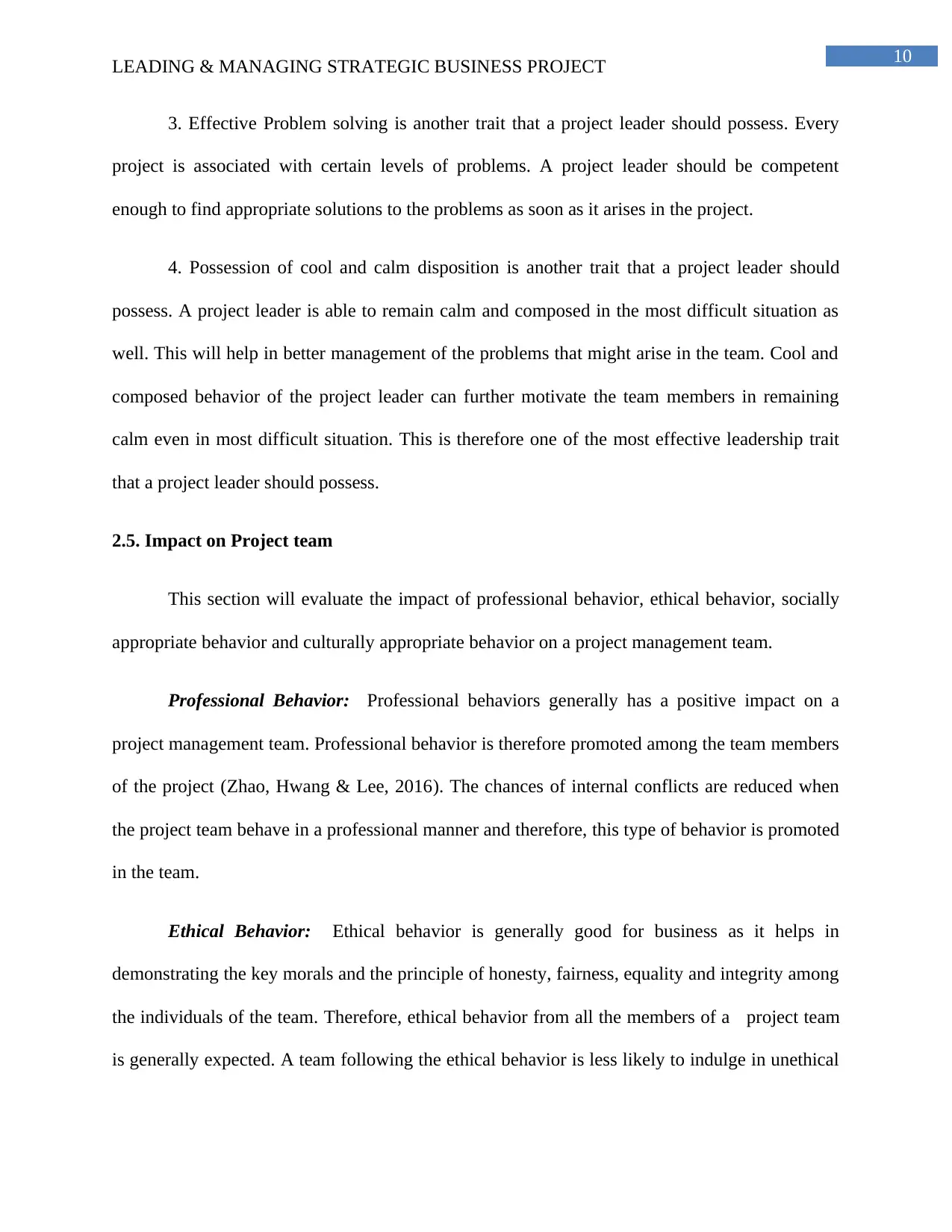
10
LEADING & MANAGING STRATEGIC BUSINESS PROJECT
3. Effective Problem solving is another trait that a project leader should possess. Every
project is associated with certain levels of problems. A project leader should be competent
enough to find appropriate solutions to the problems as soon as it arises in the project.
4. Possession of cool and calm disposition is another trait that a project leader should
possess. A project leader is able to remain calm and composed in the most difficult situation as
well. This will help in better management of the problems that might arise in the team. Cool and
composed behavior of the project leader can further motivate the team members in remaining
calm even in most difficult situation. This is therefore one of the most effective leadership trait
that a project leader should possess.
2.5. Impact on Project team
This section will evaluate the impact of professional behavior, ethical behavior, socially
appropriate behavior and culturally appropriate behavior on a project management team.
Professional Behavior: Professional behaviors generally has a positive impact on a
project management team. Professional behavior is therefore promoted among the team members
of the project (Zhao, Hwang & Lee, 2016). The chances of internal conflicts are reduced when
the project team behave in a professional manner and therefore, this type of behavior is promoted
in the team.
Ethical Behavior: Ethical behavior is generally good for business as it helps in
demonstrating the key morals and the principle of honesty, fairness, equality and integrity among
the individuals of the team. Therefore, ethical behavior from all the members of a project team
is generally expected. A team following the ethical behavior is less likely to indulge in unethical
LEADING & MANAGING STRATEGIC BUSINESS PROJECT
3. Effective Problem solving is another trait that a project leader should possess. Every
project is associated with certain levels of problems. A project leader should be competent
enough to find appropriate solutions to the problems as soon as it arises in the project.
4. Possession of cool and calm disposition is another trait that a project leader should
possess. A project leader is able to remain calm and composed in the most difficult situation as
well. This will help in better management of the problems that might arise in the team. Cool and
composed behavior of the project leader can further motivate the team members in remaining
calm even in most difficult situation. This is therefore one of the most effective leadership trait
that a project leader should possess.
2.5. Impact on Project team
This section will evaluate the impact of professional behavior, ethical behavior, socially
appropriate behavior and culturally appropriate behavior on a project management team.
Professional Behavior: Professional behaviors generally has a positive impact on a
project management team. Professional behavior is therefore promoted among the team members
of the project (Zhao, Hwang & Lee, 2016). The chances of internal conflicts are reduced when
the project team behave in a professional manner and therefore, this type of behavior is promoted
in the team.
Ethical Behavior: Ethical behavior is generally good for business as it helps in
demonstrating the key morals and the principle of honesty, fairness, equality and integrity among
the individuals of the team. Therefore, ethical behavior from all the members of a project team
is generally expected. A team following the ethical behavior is less likely to indulge in unethical
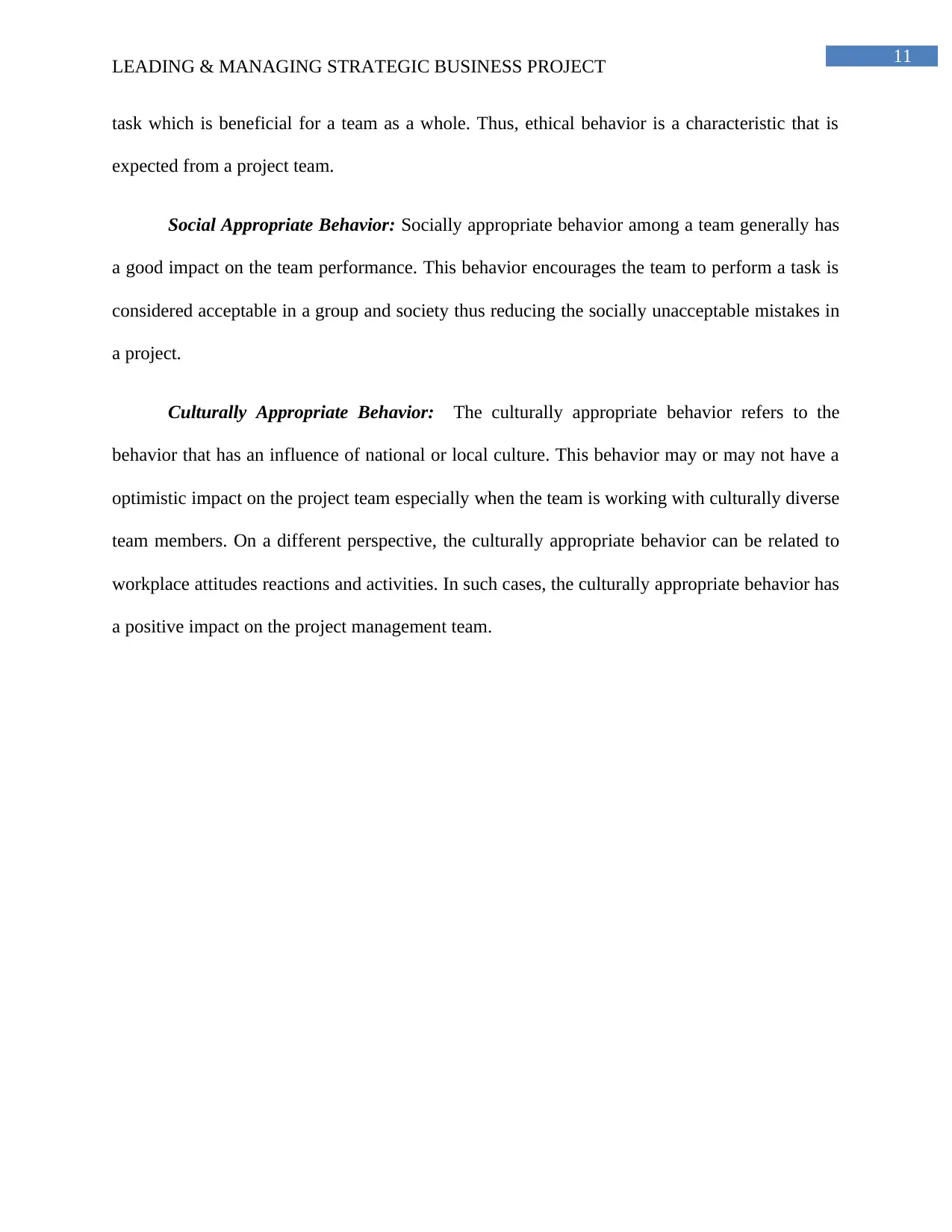
11
LEADING & MANAGING STRATEGIC BUSINESS PROJECT
task which is beneficial for a team as a whole. Thus, ethical behavior is a characteristic that is
expected from a project team.
Social Appropriate Behavior: Socially appropriate behavior among a team generally has
a good impact on the team performance. This behavior encourages the team to perform a task is
considered acceptable in a group and society thus reducing the socially unacceptable mistakes in
a project.
Culturally Appropriate Behavior: The culturally appropriate behavior refers to the
behavior that has an influence of national or local culture. This behavior may or may not have a
optimistic impact on the project team especially when the team is working with culturally diverse
team members. On a different perspective, the culturally appropriate behavior can be related to
workplace attitudes reactions and activities. In such cases, the culturally appropriate behavior has
a positive impact on the project management team.
LEADING & MANAGING STRATEGIC BUSINESS PROJECT
task which is beneficial for a team as a whole. Thus, ethical behavior is a characteristic that is
expected from a project team.
Social Appropriate Behavior: Socially appropriate behavior among a team generally has
a good impact on the team performance. This behavior encourages the team to perform a task is
considered acceptable in a group and society thus reducing the socially unacceptable mistakes in
a project.
Culturally Appropriate Behavior: The culturally appropriate behavior refers to the
behavior that has an influence of national or local culture. This behavior may or may not have a
optimistic impact on the project team especially when the team is working with culturally diverse
team members. On a different perspective, the culturally appropriate behavior can be related to
workplace attitudes reactions and activities. In such cases, the culturally appropriate behavior has
a positive impact on the project management team.
⊘ This is a preview!⊘
Do you want full access?
Subscribe today to unlock all pages.

Trusted by 1+ million students worldwide
1 out of 20
Related Documents
Your All-in-One AI-Powered Toolkit for Academic Success.
+13062052269
info@desklib.com
Available 24*7 on WhatsApp / Email
![[object Object]](/_next/static/media/star-bottom.7253800d.svg)
Unlock your academic potential
Copyright © 2020–2025 A2Z Services. All Rights Reserved. Developed and managed by ZUCOL.




